Principles of Economics: Economies of Scale, Business Cycles Analysis
VerifiedAdded on 2020/05/28
|11
|1521
|61
Report
AI Summary
This report provides an analysis of key economic principles, focusing on economies of scale, market structures (duopoly and oligopoly), and business cycles. Part A examines economies of scale, differentiating between internal and external types and their significance, particularly in oligopolistic markets like the Australian aviation sector. Part B delves into business cycles, outlining their phases and relevant macroeconomic indicators, using the French economy as a case study. The report further employs the AD-AS model to explore factors influencing economic growth in France, analyzing the impact of unemployment and inflation rates. Finally, it discusses government policies, such as investment in education, to enhance economic growth, illustrating their effects on supply and demand dynamics. The report concludes with a discussion on how government policies can enhance the economic growth of France. The report uses relevant macroeconomic indicators like GDP, inflation, and unemployment rates to determine the economic conditions of France.
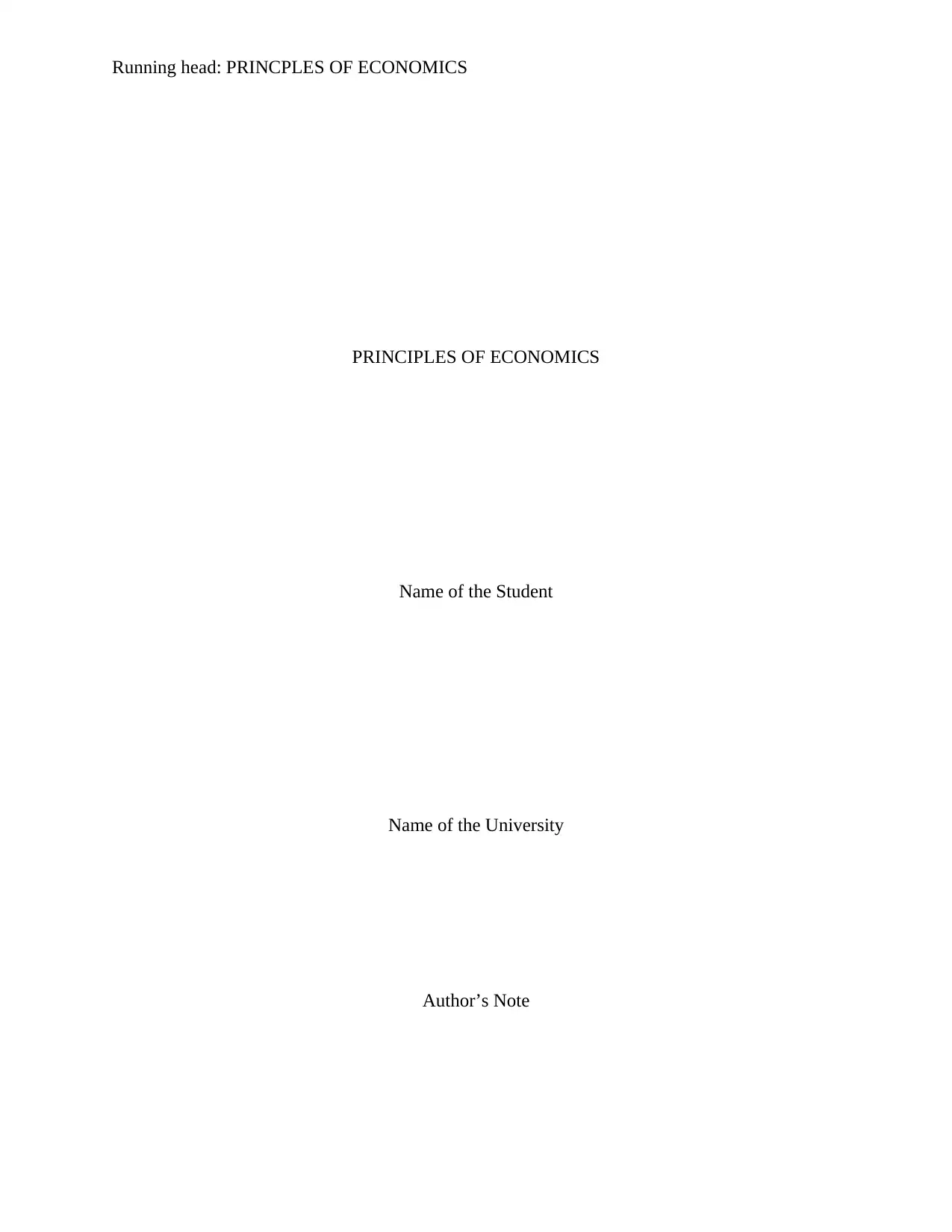
Running head: PRINCPLES OF ECONOMICS
PRINCIPLES OF ECONOMICS
Name of the Student
Name of the University
Author’s Note
PRINCIPLES OF ECONOMICS
Name of the Student
Name of the University
Author’s Note
Paraphrase This Document
Need a fresh take? Get an instant paraphrase of this document with our AI Paraphraser
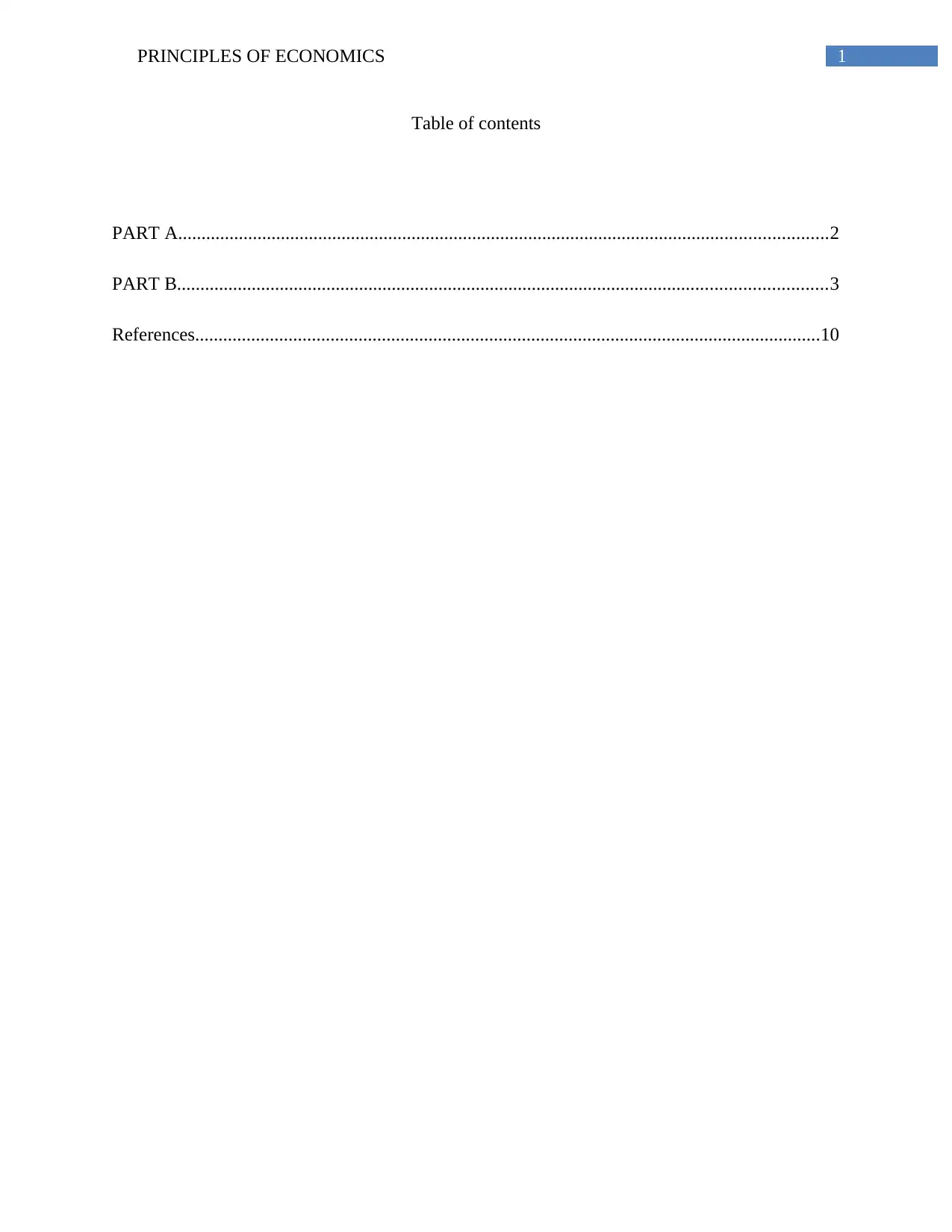
1PRINCIPLES OF ECONOMICS
Table of contents
PART A...........................................................................................................................................2
PART B...........................................................................................................................................3
References......................................................................................................................................10
Table of contents
PART A...........................................................................................................................................2
PART B...........................................................................................................................................3
References......................................................................................................................................10
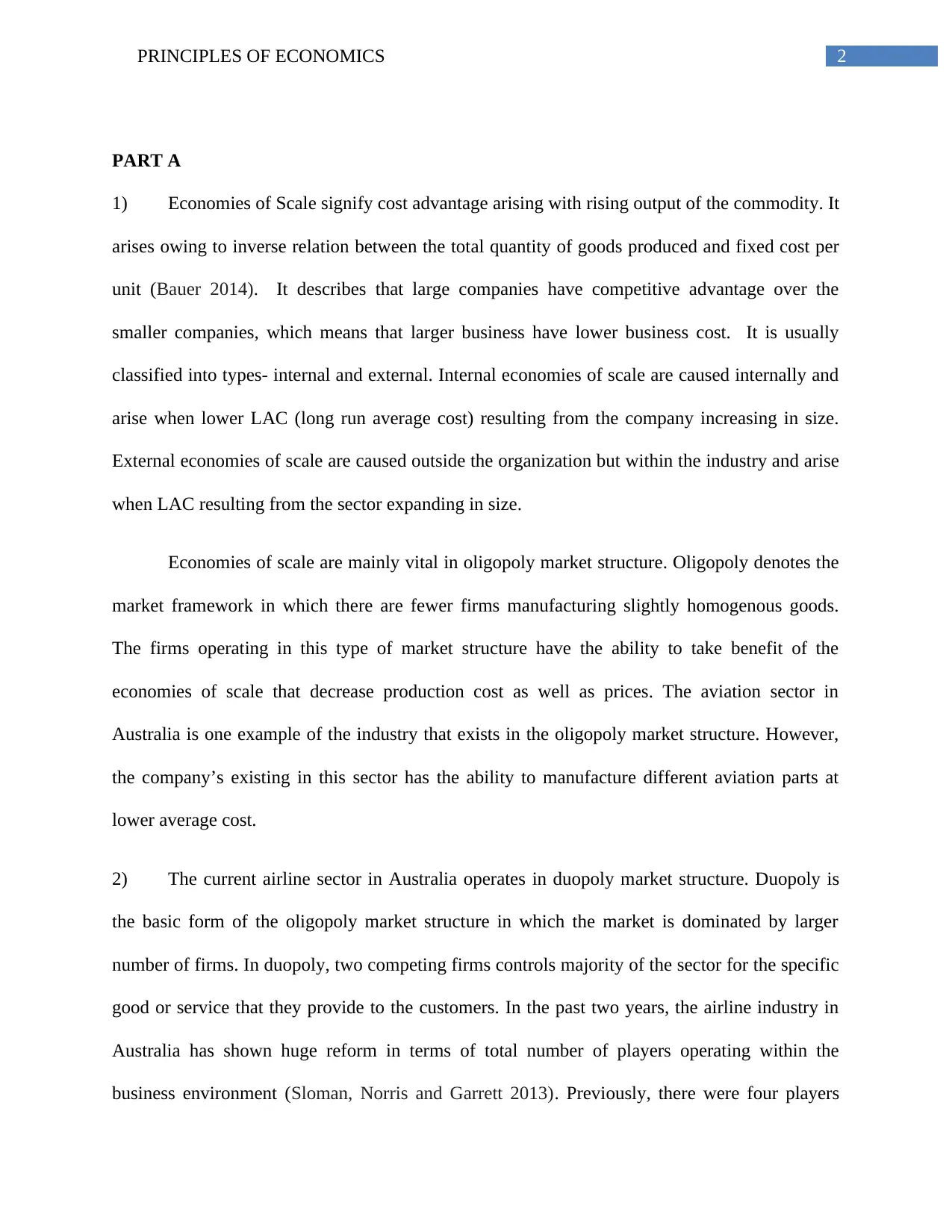
2PRINCIPLES OF ECONOMICS
PART A
1) Economies of Scale signify cost advantage arising with rising output of the commodity. It
arises owing to inverse relation between the total quantity of goods produced and fixed cost per
unit (Bauer 2014). It describes that large companies have competitive advantage over the
smaller companies, which means that larger business have lower business cost. It is usually
classified into types- internal and external. Internal economies of scale are caused internally and
arise when lower LAC (long run average cost) resulting from the company increasing in size.
External economies of scale are caused outside the organization but within the industry and arise
when LAC resulting from the sector expanding in size.
Economies of scale are mainly vital in oligopoly market structure. Oligopoly denotes the
market framework in which there are fewer firms manufacturing slightly homogenous goods.
The firms operating in this type of market structure have the ability to take benefit of the
economies of scale that decrease production cost as well as prices. The aviation sector in
Australia is one example of the industry that exists in the oligopoly market structure. However,
the company’s existing in this sector has the ability to manufacture different aviation parts at
lower average cost.
2) The current airline sector in Australia operates in duopoly market structure. Duopoly is
the basic form of the oligopoly market structure in which the market is dominated by larger
number of firms. In duopoly, two competing firms controls majority of the sector for the specific
good or service that they provide to the customers. In the past two years, the airline industry in
Australia has shown huge reform in terms of total number of players operating within the
business environment (Sloman, Norris and Garrett 2013). Previously, there were four players
PART A
1) Economies of Scale signify cost advantage arising with rising output of the commodity. It
arises owing to inverse relation between the total quantity of goods produced and fixed cost per
unit (Bauer 2014). It describes that large companies have competitive advantage over the
smaller companies, which means that larger business have lower business cost. It is usually
classified into types- internal and external. Internal economies of scale are caused internally and
arise when lower LAC (long run average cost) resulting from the company increasing in size.
External economies of scale are caused outside the organization but within the industry and arise
when LAC resulting from the sector expanding in size.
Economies of scale are mainly vital in oligopoly market structure. Oligopoly denotes the
market framework in which there are fewer firms manufacturing slightly homogenous goods.
The firms operating in this type of market structure have the ability to take benefit of the
economies of scale that decrease production cost as well as prices. The aviation sector in
Australia is one example of the industry that exists in the oligopoly market structure. However,
the company’s existing in this sector has the ability to manufacture different aviation parts at
lower average cost.
2) The current airline sector in Australia operates in duopoly market structure. Duopoly is
the basic form of the oligopoly market structure in which the market is dominated by larger
number of firms. In duopoly, two competing firms controls majority of the sector for the specific
good or service that they provide to the customers. In the past two years, the airline industry in
Australia has shown huge reform in terms of total number of players operating within the
business environment (Sloman, Norris and Garrett 2013). Previously, there were four players
⊘ This is a preview!⊘
Do you want full access?
Subscribe today to unlock all pages.

Trusted by 1+ million students worldwide
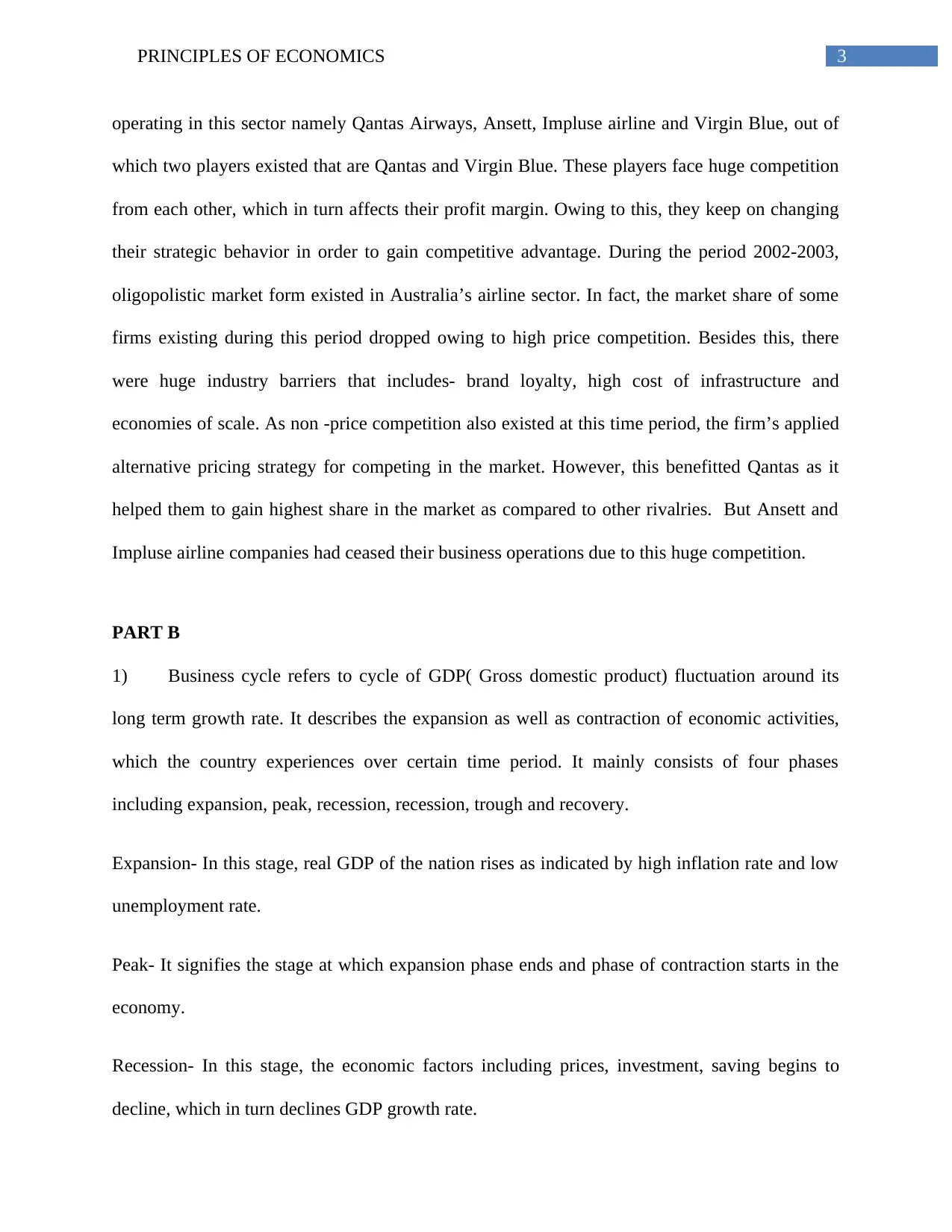
3PRINCIPLES OF ECONOMICS
operating in this sector namely Qantas Airways, Ansett, Impluse airline and Virgin Blue, out of
which two players existed that are Qantas and Virgin Blue. These players face huge competition
from each other, which in turn affects their profit margin. Owing to this, they keep on changing
their strategic behavior in order to gain competitive advantage. During the period 2002-2003,
oligopolistic market form existed in Australia’s airline sector. In fact, the market share of some
firms existing during this period dropped owing to high price competition. Besides this, there
were huge industry barriers that includes- brand loyalty, high cost of infrastructure and
economies of scale. As non -price competition also existed at this time period, the firm’s applied
alternative pricing strategy for competing in the market. However, this benefitted Qantas as it
helped them to gain highest share in the market as compared to other rivalries. But Ansett and
Impluse airline companies had ceased their business operations due to this huge competition.
PART B
1) Business cycle refers to cycle of GDP( Gross domestic product) fluctuation around its
long term growth rate. It describes the expansion as well as contraction of economic activities,
which the country experiences over certain time period. It mainly consists of four phases
including expansion, peak, recession, recession, trough and recovery.
Expansion- In this stage, real GDP of the nation rises as indicated by high inflation rate and low
unemployment rate.
Peak- It signifies the stage at which expansion phase ends and phase of contraction starts in the
economy.
Recession- In this stage, the economic factors including prices, investment, saving begins to
decline, which in turn declines GDP growth rate.
operating in this sector namely Qantas Airways, Ansett, Impluse airline and Virgin Blue, out of
which two players existed that are Qantas and Virgin Blue. These players face huge competition
from each other, which in turn affects their profit margin. Owing to this, they keep on changing
their strategic behavior in order to gain competitive advantage. During the period 2002-2003,
oligopolistic market form existed in Australia’s airline sector. In fact, the market share of some
firms existing during this period dropped owing to high price competition. Besides this, there
were huge industry barriers that includes- brand loyalty, high cost of infrastructure and
economies of scale. As non -price competition also existed at this time period, the firm’s applied
alternative pricing strategy for competing in the market. However, this benefitted Qantas as it
helped them to gain highest share in the market as compared to other rivalries. But Ansett and
Impluse airline companies had ceased their business operations due to this huge competition.
PART B
1) Business cycle refers to cycle of GDP( Gross domestic product) fluctuation around its
long term growth rate. It describes the expansion as well as contraction of economic activities,
which the country experiences over certain time period. It mainly consists of four phases
including expansion, peak, recession, recession, trough and recovery.
Expansion- In this stage, real GDP of the nation rises as indicated by high inflation rate and low
unemployment rate.
Peak- It signifies the stage at which expansion phase ends and phase of contraction starts in the
economy.
Recession- In this stage, the economic factors including prices, investment, saving begins to
decline, which in turn declines GDP growth rate.
Paraphrase This Document
Need a fresh take? Get an instant paraphrase of this document with our AI Paraphraser
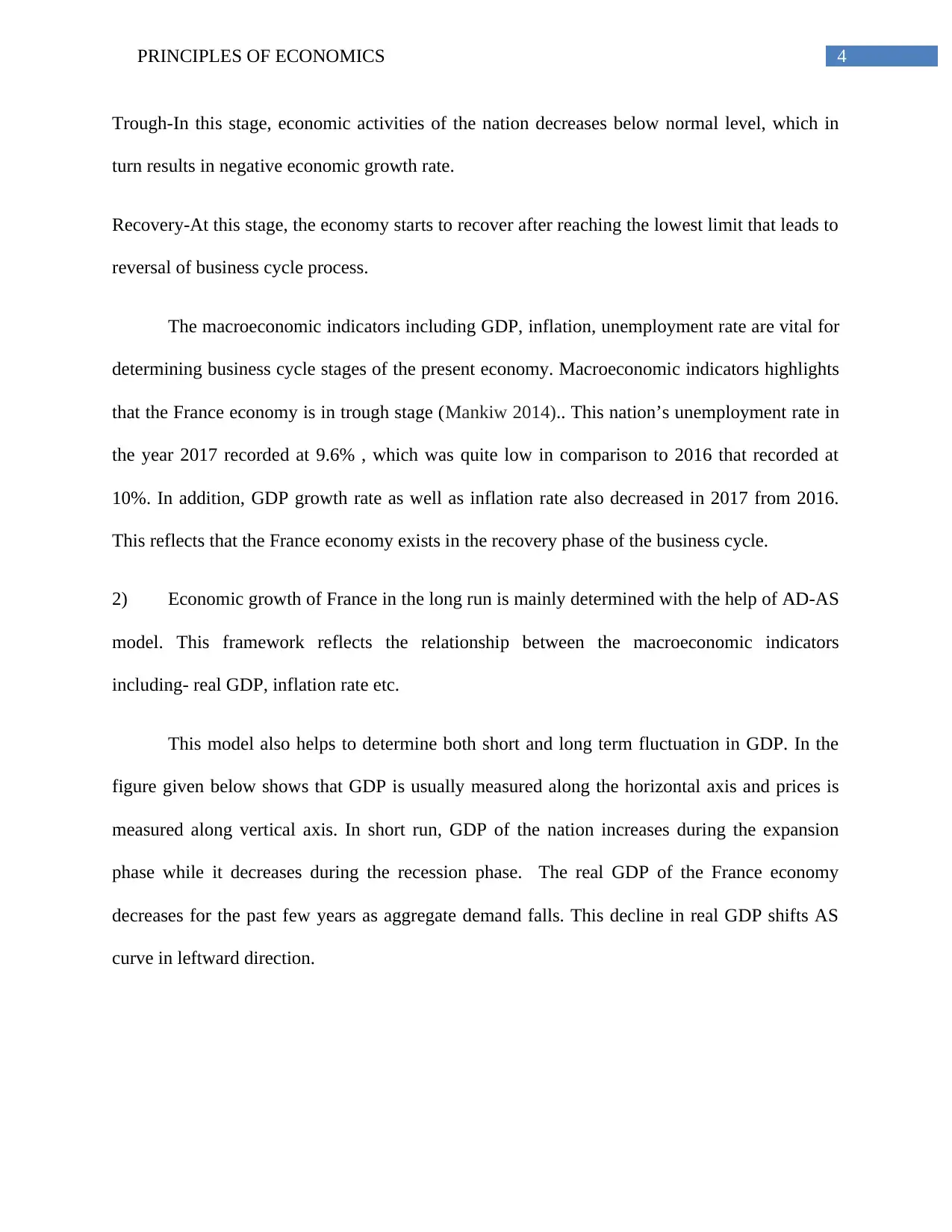
4PRINCIPLES OF ECONOMICS
Trough-In this stage, economic activities of the nation decreases below normal level, which in
turn results in negative economic growth rate.
Recovery-At this stage, the economy starts to recover after reaching the lowest limit that leads to
reversal of business cycle process.
The macroeconomic indicators including GDP, inflation, unemployment rate are vital for
determining business cycle stages of the present economy. Macroeconomic indicators highlights
that the France economy is in trough stage (Mankiw 2014).. This nation’s unemployment rate in
the year 2017 recorded at 9.6% , which was quite low in comparison to 2016 that recorded at
10%. In addition, GDP growth rate as well as inflation rate also decreased in 2017 from 2016.
This reflects that the France economy exists in the recovery phase of the business cycle.
2) Economic growth of France in the long run is mainly determined with the help of AD-AS
model. This framework reflects the relationship between the macroeconomic indicators
including- real GDP, inflation rate etc.
This model also helps to determine both short and long term fluctuation in GDP. In the
figure given below shows that GDP is usually measured along the horizontal axis and prices is
measured along vertical axis. In short run, GDP of the nation increases during the expansion
phase while it decreases during the recession phase. The real GDP of the France economy
decreases for the past few years as aggregate demand falls. This decline in real GDP shifts AS
curve in leftward direction.
Trough-In this stage, economic activities of the nation decreases below normal level, which in
turn results in negative economic growth rate.
Recovery-At this stage, the economy starts to recover after reaching the lowest limit that leads to
reversal of business cycle process.
The macroeconomic indicators including GDP, inflation, unemployment rate are vital for
determining business cycle stages of the present economy. Macroeconomic indicators highlights
that the France economy is in trough stage (Mankiw 2014).. This nation’s unemployment rate in
the year 2017 recorded at 9.6% , which was quite low in comparison to 2016 that recorded at
10%. In addition, GDP growth rate as well as inflation rate also decreased in 2017 from 2016.
This reflects that the France economy exists in the recovery phase of the business cycle.
2) Economic growth of France in the long run is mainly determined with the help of AD-AS
model. This framework reflects the relationship between the macroeconomic indicators
including- real GDP, inflation rate etc.
This model also helps to determine both short and long term fluctuation in GDP. In the
figure given below shows that GDP is usually measured along the horizontal axis and prices is
measured along vertical axis. In short run, GDP of the nation increases during the expansion
phase while it decreases during the recession phase. The real GDP of the France economy
decreases for the past few years as aggregate demand falls. This decline in real GDP shifts AS
curve in leftward direction.
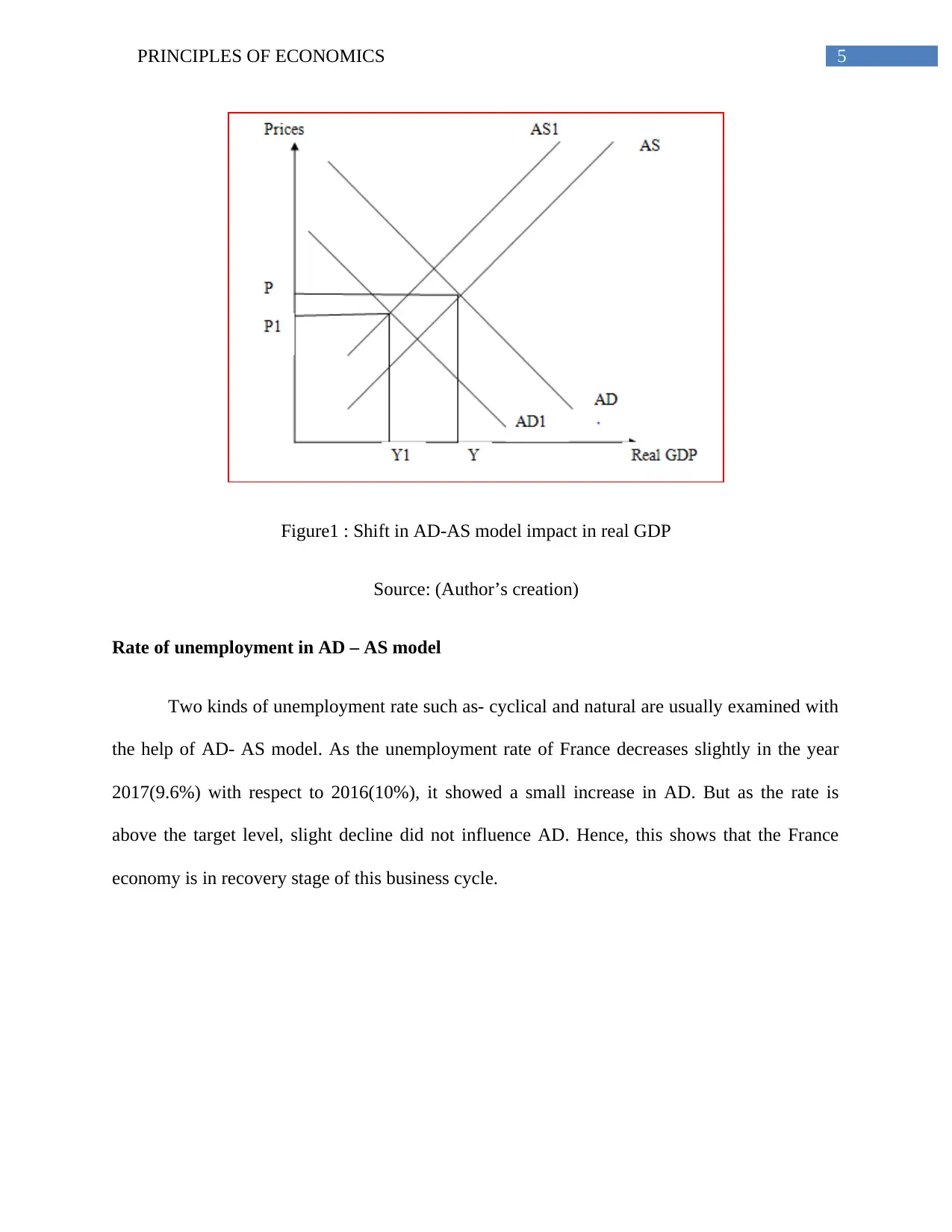
5PRINCIPLES OF ECONOMICS
Figure1 : Shift in AD-AS model impact in real GDP
Source: (Author’s creation)
Rate of unemployment in AD – AS model
Two kinds of unemployment rate such as- cyclical and natural are usually examined with
the help of AD- AS model. As the unemployment rate of France decreases slightly in the year
2017(9.6%) with respect to 2016(10%), it showed a small increase in AD. But as the rate is
above the target level, slight decline did not influence AD. Hence, this shows that the France
economy is in recovery stage of this business cycle.
Figure1 : Shift in AD-AS model impact in real GDP
Source: (Author’s creation)
Rate of unemployment in AD – AS model
Two kinds of unemployment rate such as- cyclical and natural are usually examined with
the help of AD- AS model. As the unemployment rate of France decreases slightly in the year
2017(9.6%) with respect to 2016(10%), it showed a small increase in AD. But as the rate is
above the target level, slight decline did not influence AD. Hence, this shows that the France
economy is in recovery stage of this business cycle.
⊘ This is a preview!⊘
Do you want full access?
Subscribe today to unlock all pages.

Trusted by 1+ million students worldwide
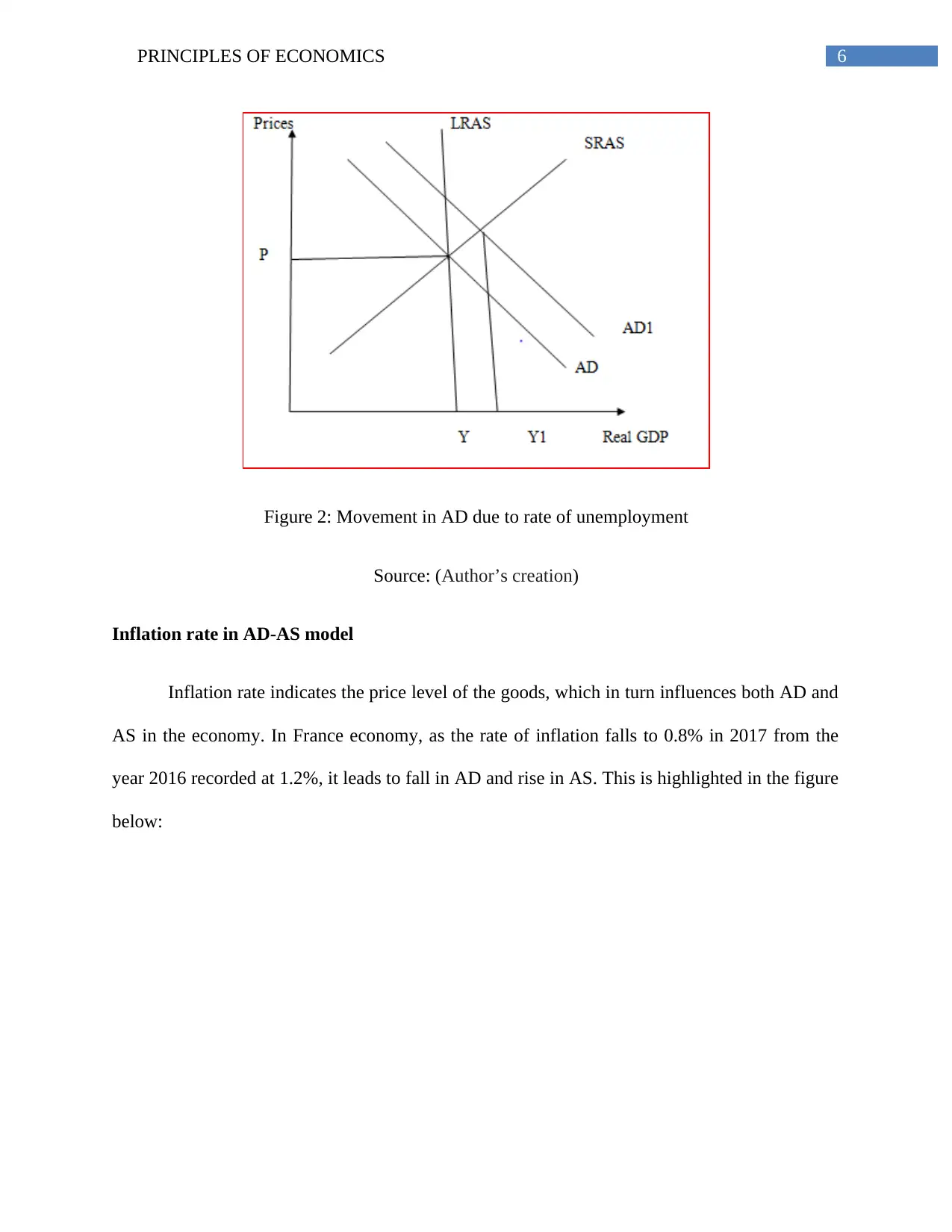
6PRINCIPLES OF ECONOMICS
Figure 2: Movement in AD due to rate of unemployment
Source: (Author’s creation)
Inflation rate in AD-AS model
Inflation rate indicates the price level of the goods, which in turn influences both AD and
AS in the economy. In France economy, as the rate of inflation falls to 0.8% in 2017 from the
year 2016 recorded at 1.2%, it leads to fall in AD and rise in AS. This is highlighted in the figure
below:
Figure 2: Movement in AD due to rate of unemployment
Source: (Author’s creation)
Inflation rate in AD-AS model
Inflation rate indicates the price level of the goods, which in turn influences both AD and
AS in the economy. In France economy, as the rate of inflation falls to 0.8% in 2017 from the
year 2016 recorded at 1.2%, it leads to fall in AD and rise in AS. This is highlighted in the figure
below:
Paraphrase This Document
Need a fresh take? Get an instant paraphrase of this document with our AI Paraphraser

7PRINCIPLES OF ECONOMICS
Figure 3: Increase in AS leading to fall in inflation
Source: (Author’s creation)
Figure 4: Fall in AD leading to decline in inflation
Figure 3: Increase in AS leading to fall in inflation
Source: (Author’s creation)
Figure 4: Fall in AD leading to decline in inflation
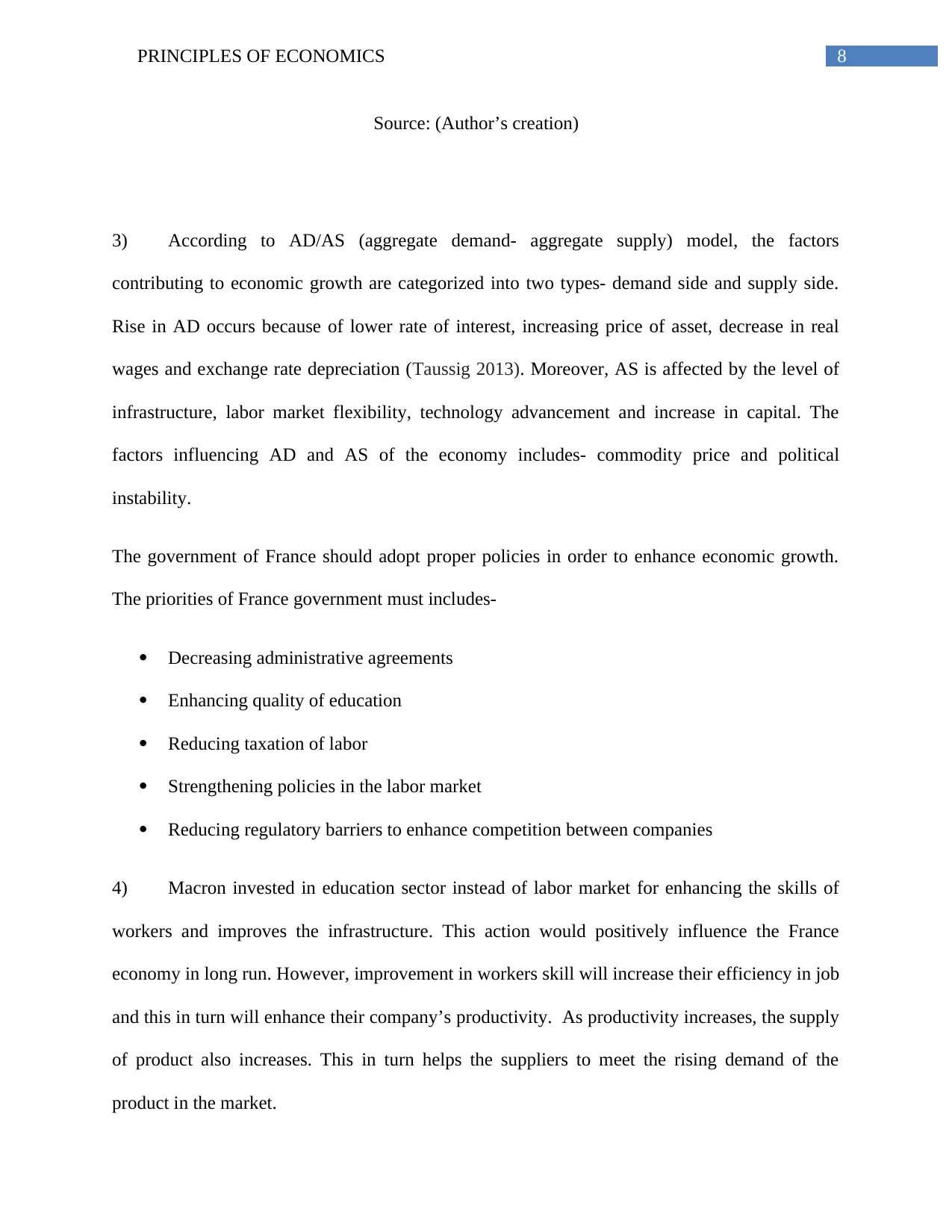
8PRINCIPLES OF ECONOMICS
Source: (Author’s creation)
3) According to AD/AS (aggregate demand- aggregate supply) model, the factors
contributing to economic growth are categorized into two types- demand side and supply side.
Rise in AD occurs because of lower rate of interest, increasing price of asset, decrease in real
wages and exchange rate depreciation (Taussig 2013). Moreover, AS is affected by the level of
infrastructure, labor market flexibility, technology advancement and increase in capital. The
factors influencing AD and AS of the economy includes- commodity price and political
instability.
The government of France should adopt proper policies in order to enhance economic growth.
The priorities of France government must includes-
Decreasing administrative agreements
Enhancing quality of education
Reducing taxation of labor
Strengthening policies in the labor market
Reducing regulatory barriers to enhance competition between companies
4) Macron invested in education sector instead of labor market for enhancing the skills of
workers and improves the infrastructure. This action would positively influence the France
economy in long run. However, improvement in workers skill will increase their efficiency in job
and this in turn will enhance their company’s productivity. As productivity increases, the supply
of product also increases. This in turn helps the suppliers to meet the rising demand of the
product in the market.
Source: (Author’s creation)
3) According to AD/AS (aggregate demand- aggregate supply) model, the factors
contributing to economic growth are categorized into two types- demand side and supply side.
Rise in AD occurs because of lower rate of interest, increasing price of asset, decrease in real
wages and exchange rate depreciation (Taussig 2013). Moreover, AS is affected by the level of
infrastructure, labor market flexibility, technology advancement and increase in capital. The
factors influencing AD and AS of the economy includes- commodity price and political
instability.
The government of France should adopt proper policies in order to enhance economic growth.
The priorities of France government must includes-
Decreasing administrative agreements
Enhancing quality of education
Reducing taxation of labor
Strengthening policies in the labor market
Reducing regulatory barriers to enhance competition between companies
4) Macron invested in education sector instead of labor market for enhancing the skills of
workers and improves the infrastructure. This action would positively influence the France
economy in long run. However, improvement in workers skill will increase their efficiency in job
and this in turn will enhance their company’s productivity. As productivity increases, the supply
of product also increases. This in turn helps the suppliers to meet the rising demand of the
product in the market.
⊘ This is a preview!⊘
Do you want full access?
Subscribe today to unlock all pages.

Trusted by 1+ million students worldwide
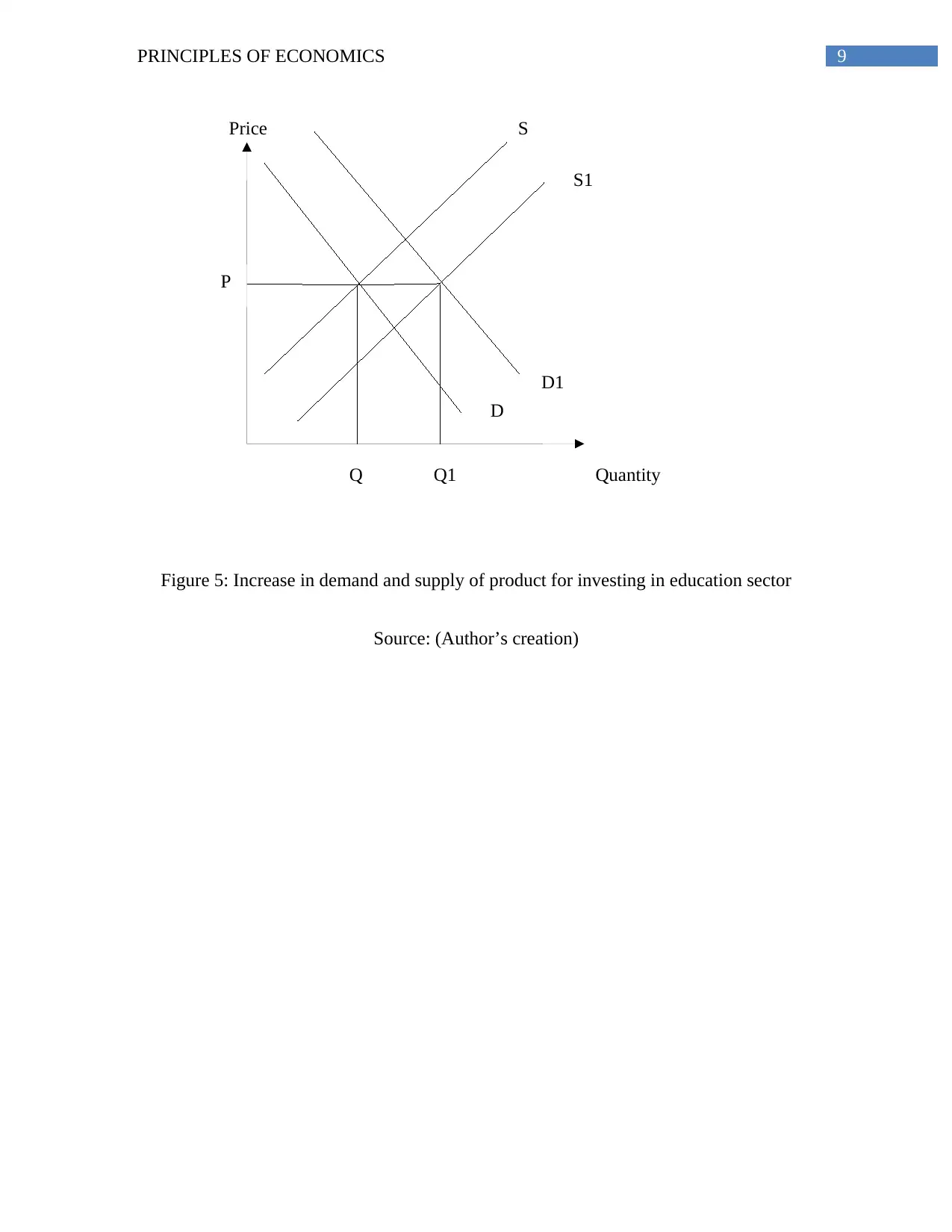
9PRINCIPLES OF ECONOMICS
Quantity
Price
D
D1
S1
S
P
Q Q1
Figure 5: Increase in demand and supply of product for investing in education sector
Source: (Author’s creation)
Quantity
Price
D
D1
S1
S
P
Q Q1
Figure 5: Increase in demand and supply of product for investing in education sector
Source: (Author’s creation)
Paraphrase This Document
Need a fresh take? Get an instant paraphrase of this document with our AI Paraphraser
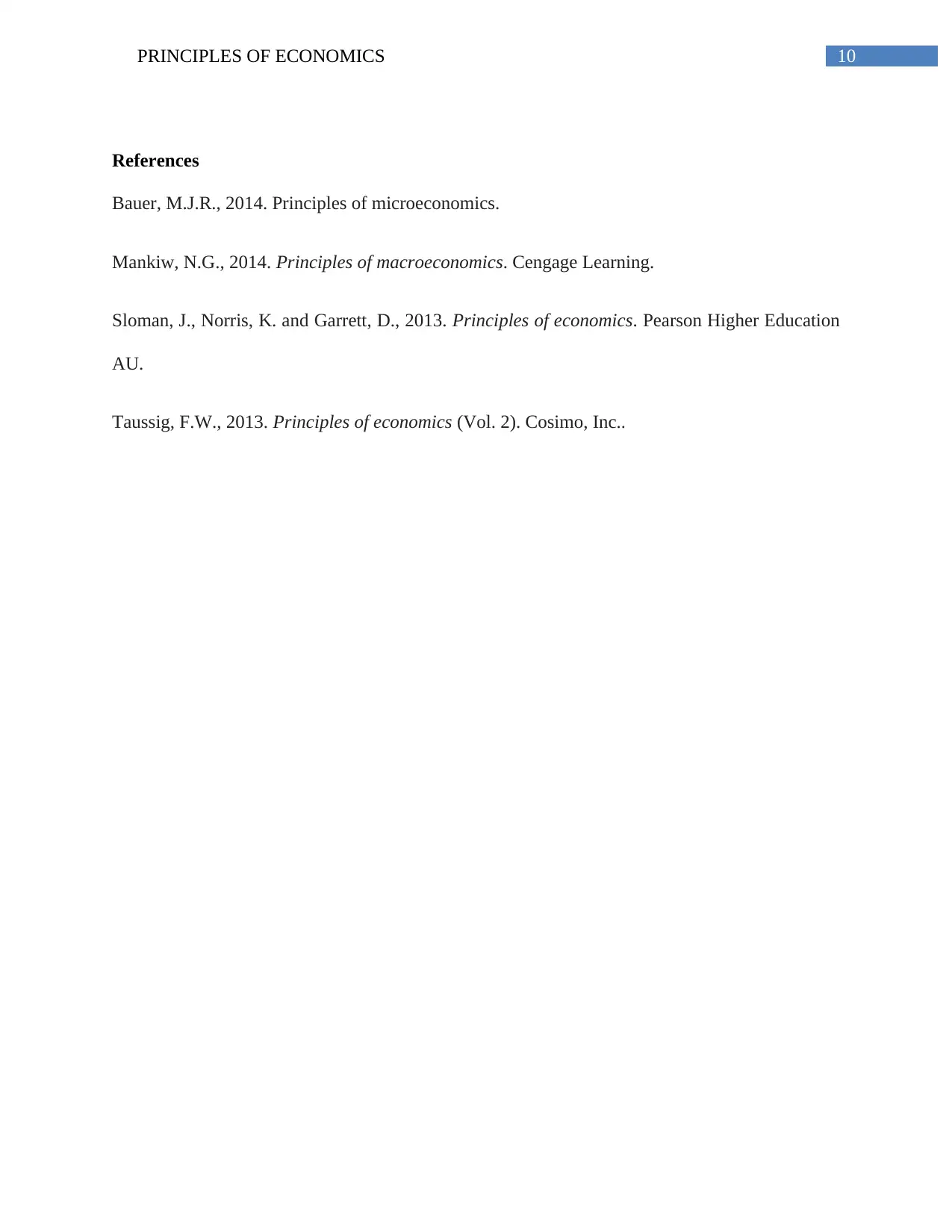
10PRINCIPLES OF ECONOMICS
References
Bauer, M.J.R., 2014. Principles of microeconomics.
Mankiw, N.G., 2014. Principles of macroeconomics. Cengage Learning.
Sloman, J., Norris, K. and Garrett, D., 2013. Principles of economics. Pearson Higher Education
AU.
Taussig, F.W., 2013. Principles of economics (Vol. 2). Cosimo, Inc..
References
Bauer, M.J.R., 2014. Principles of microeconomics.
Mankiw, N.G., 2014. Principles of macroeconomics. Cengage Learning.
Sloman, J., Norris, K. and Garrett, D., 2013. Principles of economics. Pearson Higher Education
AU.
Taussig, F.W., 2013. Principles of economics (Vol. 2). Cosimo, Inc..
1 out of 11
Related Documents
Your All-in-One AI-Powered Toolkit for Academic Success.
+13062052269
info@desklib.com
Available 24*7 on WhatsApp / Email
![[object Object]](/_next/static/media/star-bottom.7253800d.svg)
Unlock your academic potential
Copyright © 2020–2025 A2Z Services. All Rights Reserved. Developed and managed by ZUCOL.





